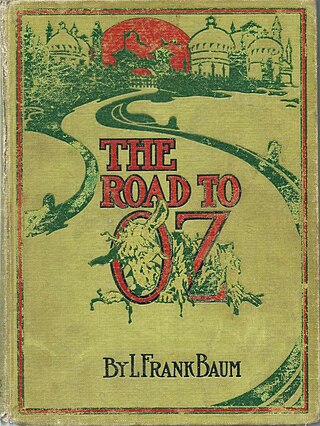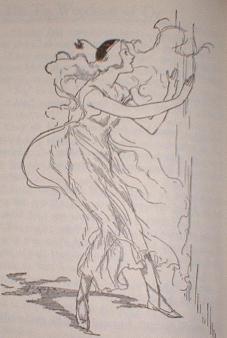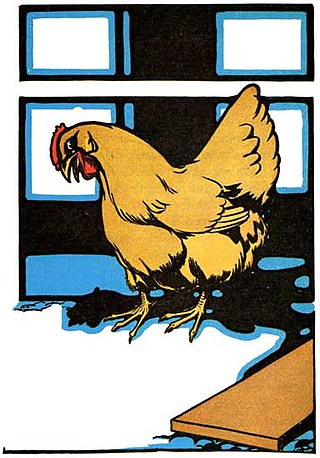
Lyman Frank Baum was an American author best known for his children's fantasy books, particularly The Wonderful Wizard of Oz, part of a series. In addition to the 14 Oz books, Baum penned 41 other novels, 83 short stories, over 200 poems, and at least 42 scripts. He made numerous attempts to bring his works to the stage and screen; the 1939 adaptation of the first Oz book became a landmark of 20th-century cinema.

The Road to Oz is the fifth book in L. Frank Baum's Oz series. It was originally published on July 10, 1909 and documents the adventures of Dorothy Gale's fourth visit to the Land of Oz. It was followed by The Emerald City of Oz (1910).

Tik-Tok of Oz is the eighth book in the Oz series written by L. Frank Baum, published on June 19, 1914. The book has little to do with Tik-Tok and is primarily the quest of the Shaggy Man to rescue his brother, and his resulting conflict with the Nome King. The book was based on Baum's play The Tik-Tok Man of Oz, which was produced in Los Angeles in spring 1913. It was followed by The Scarecrow of Oz (1915).

The Magic of Oz is the thirteenth book in the Oz series written by L. Frank Baum. Published on June 7, 1919, one month after the author's death, The Magic of Oz relates the unsuccessful attempt of the Munchkin boy Kiki Aru and former Nome King Ruggedo to conquer Oz. It was followed by Glinda of Oz (1920).

The Land of Oz is a magical country introduced in the 1900 children's novel The Wonderful Wizard of Oz written by L. Frank Baum and illustrated by W. W. Denslow.

The Deadly Desert is the magical desert in Nonestica that completely surrounds the fictional Land of Oz, which cuts it off from the rest of the world.

Tik-Tok is a fictional "mechanical man" from the Oz books by American author L. Frank Baum. He has been termed "the prototype robot", and is widely considered to be one of the first robots to appear in modern literature, though the term "Robot" was not used until the 1920s, in the play R.U.R.
Oz Squad is a comic book series using characters and setting from L. Frank Baum's Land of Oz series, "updated for a more adult audience".

The Nome King is a fictional character created by American author L. Frank Baum. He is introduced in Baum's third Oz book Ozma of Oz (1907). He also appears in many of the continuing sequel Oz novels also written by Baum. Although the character of the Wicked Witch of the West is the most notable and famous Oz villain, it is actually the Nome King who is the most frequent antagonist in the book series.

Polychrome is a cloud fairy and the youngest daughter of the Rainbow, thus she is a "sky princess". She first appears in The Road to Oz (1909), which is the fifth book of the original fourteen Oz books by American author by L. Frank Baum. She also appears several times in later Oz stories of the classic series, and has a title role in the modern sequel Polychrome: A Romantic Fantasy by Ryk E. Spoor.

Billina is a fictional character in the classic children's series of Oz books by American author L. Frank Baum. She is introduced in Ozma of Oz (1907).
The Shaggy Man is a character in the Oz books by L. Frank Baum. He first appeared in the book The Road to Oz in 1909.
Oz Before the Rainbow is a book written by Mark Evan Swartz in 2000 chronicling the early stage and film versions of The Wizard of Oz, before the 1939 movie, as well as an album featuring music from the early stage versions.

The Patchwork Girl of Oz (1914) is a silent film made by L. Frank Baum's The Oz Film Manufacturing Company. It was based on the 1913 book The Patchwork Girl of Oz.

The Wonderful Wizard of Oz is a 1900 children's novel written by American author L. Frank Baum. Since its first publication in 1900, it has been adapted many times by L. Frank Baum and others: for film, television, theatre, books, comics, games, and other media.

Queen Ann in Oz is a 1993 children's novel written by Karyl Carlson and Eric Gjovaag, and illustrated by William Campbell and Irwin Terry. The book is an entry in the large and growing literature in the Oz series, begun by L. Frank Baum and continued by many successors.

Prince Silverwings and Other Stories is a 1902 children's book by Edith Ogden Harrison. The book is best known because she collaborated with L. Frank Baum on an uncompleted stage adaptation of the book as a musical extravaganza. Baum composed music for the play as well, and at least one of these songs, "Down Among the Marshes," survives and has been recorded by James Patrick Doyle on his 1999 album, Before the Rainbow: The Original Music of Oz, and Baum scholar Michael O. Riley published a complete edition of their Scenario and General Synopsis for the play through the Pamami Press in 1982 in a limited run of 125 copies in white cloth bound in purple with illustrations by Dick Martin. It is otherwise known only from a typescript in the Chicago Historical Society.
The plays of L. Frank Baum are an aspect of Baum's writing career about which very little is known. While most biographies have noted Baum's work as a playwright, these works have been rarely performed beyond his lifetime, and almost none have been published aside from two scenarios and a first act of three unfinished works in The Musical Fantasies of L. Frank Baum, compiled with an introduction by Alla T. Ford. Aside from his youthful success with The Maid of Arran, his blockbuster eight-year run with The Wizard of Oz, his failure with The Woggle-Bug, and The Tik-Tok Man of Oz as source material for his novel, Tik-Tok of Oz, very little is known about his dramatic output, and mostly from the publications of Michael Patrick Hearn, Susan Ferrara, and Katharine M. Rogers. Hearn identifies 41 different titles in the bibliography of the 2000 edition of The Annotated Wizard of Oz, plus one play without a title, although some of these titles clearly refer to drafts of the same play, such as the early titles of The Tik-Tok Man of Oz.
This is a complete bibliography for American children's writer L. Frank Baum.















